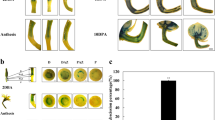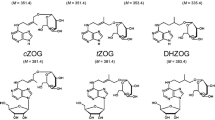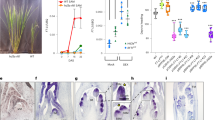Abstract
THE flower buds of certain varieties of Phaseolus vulgaris absciss in British summers, a phenomenon which is induced when the plants are grown in day lengths longer than 13–14 h1. The number of buds which absciss increases as the day length is extended1–3. This post-initiation effect is truly photoperiodic, the photoperiodic stimulus being received in the leaves and the inhibitory effects expressed in the buds, the growth of which is inhibited before they finally drop2–5. Experiments in which a single trifoliate leaf was exposed to a photoperiod different from the rest of the plant provided indirect evidence that the effects of photoperiod on flower bud development were mediated through the production of substances in the leaves, with a predominance of inhibitor(s) being formed in long days and of promoter(s) in short days3,4. We describe here the determination in a single sensitive variety, classified as P47, of the chemical basis for the inhibitory and promotory effects of long and short days respectively.
This is a preview of subscription content, access via your institution
Access options
Subscribe to this journal
Receive 51 print issues and online access
$199.00 per year
only $3.90 per issue
Buy this article
- Purchase on Springer Link
- Instant access to full article PDF
Prices may be subject to local taxes which are calculated during checkout
Similar content being viewed by others
References
Ojehomon, O. O., Rathjen, A. S., and Morgan, D. G., J. agric. Sci., 71, 209–214 (1968).
Zehni, M. S., and Morgan, D. G., Ann. Bot. (in the press).
Zehni, M. S., thesis, Univ. Cambridge (1969).
Zehni, M. S., Saad, F. A., and Morgan, D. G., Nature, 227, 628–629 (1970).
Ojehomon, O. O., Zehni, M. S., and Morgan, D. G., Ann. Bot., 37, 871–884 (1973).
Bentley, B., thesis, Univ. Cambridge (1974).
Milborrow, B. V., J. exp. Bot., 21, 17–29 (1970).
Wright, S. T. C., Planta, 86, 10–20 (1969).
Lenton, J. R., Perry, V. M., and Saunders, P. F., Planta, 96, 271–280 (1971).
Saad, F. A., thesis, Univ. Cambridge (1972).
Heide, O. M., and Skoog, F., Physiol. Plant., 20, 771–780 (1967).
Woolhouse, H. W., and Beever, J. E., Nature new Biol., 246, 31–32 (1973).
Evans, L. T., Induction of Flowering—some Case Histories (Macmillan, Melbourne 1969).
Author information
Authors and Affiliations
Rights and permissions
About this article
Cite this article
BENTLEY, B., MORGAN, C., MORGAN, D. et al. Plant growth substances and effects of photoperiod on flower bud development in Phaseolus vulgaris. Nature 256, 121–122 (1975). https://doi.org/10.1038/256121a0
Received:
Accepted:
Issue Date:
DOI: https://doi.org/10.1038/256121a0
This article is cited by
Comments
By submitting a comment you agree to abide by our Terms and Community Guidelines. If you find something abusive or that does not comply with our terms or guidelines please flag it as inappropriate.



